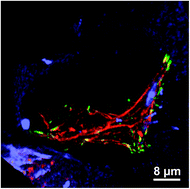Three-dimensional fibroblast morphology on compliant substrates of controlled negative curvature†
Abstract
Traditionally, cell biological investigations have mostly employed cells growing on flat, two-dimensional, hard substrates, which are of questionable utility in mimicking microenvironments in vivo. We engineered a novel scaffold to achieve cell culture in the third dimension (3D), where fibroblasts lose the strong dorsal–ventral asymmetry in the distribution of cytoskeletal and adhesion components that is induced by growth on flat substrates. The design principle of our new 3D substrate was inspired by recent advances in engineering cellular microenvironments in which rigidity and the patterning of adhesion ligands were tuned on two-dimensional substrates; the engineered substrates enable independent control over biochemical and mechanical factors to elucidate how mechanical cues affect cellular behaviours. The 3D substrates consisted of polyacrylamide scaffolds of highly ordered, uniform pores coated with extracellular matrix proteins. We characterized important parameters for fabrication and the mechanical properties of polyacrylamide scaffolds. We then grew individual fibroblasts in the identical pores of the polyacrylamide scaffolds, examining cellular morphological, actin cytoskeletal, and adhesion properties. We found that fibroblasts sense the local rigidity of the scaffold, and exhibit a 3D distribution of actin cytoskeleton and adhesions that became more pronounced as the pore size was reduced. In small pores, we observed that elongated adhesions can exist without attachment to any solid support. Taken together, our results show that the use of negatively curved surfaces is a simple method to induce cell adhesions in 3D, opening up new degrees of freedom to explore cellular behaviours.


 Please wait while we load your content...
Please wait while we load your content...